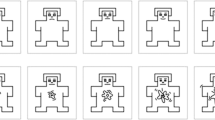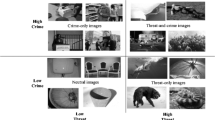Abstract
Objectives
Researchers have been studying the most important environmental cues that influence people’s fear and how to measure these emotions and perceptions in a more valid way. In order to contribute to experimental studies, we develop and validate the Urban Security Image Database (USID).
Method
The construction and validation of the USID followed two stages: (a) the obtainment by researchers of more than 300 naturalistic pictures in different urban contexts of the city of Porto and (b) using a within-subject design, a large sample (N = 1780) classified 49 selected pictures for fear of crime, risk perception of victimization, arousal, and valence levels.
Results
The validated Urban Security Image Database (USID) contains 49 pictures that are grouped in three categories according to fear mean levels: low fear, neutral fear, and high fear. Pictures of the low fear group depict residential areas, with high prospect spaces and well-cared vegetation. Pictures in the high fear group represent scenarios in night-time, with signs of incivilities and low prospect spaces. Fear of crime was negatively correlated with valence and positively with arousal.
Conclusions
USID is an important step to laboratorial experiments in the field of fear of crime and its relationship with environmental features. Moreover, since fear of crime is correlated with valence and arousal, it provides strength to the importance of considering fear a context-specific experience.


Similar content being viewed by others
Notes
Due to an error detected when the survey was ready to be launched (one of the pictures previously selected was repeated), 24 instead of 25 pictures were evaluated by the external sample.
References
Andrews, M., & Gatersleben, B. (2010). Variations in perception of danger, fear and preference in a simulated natural environment. Journal of Environmental Psychology, 30, 473–481.
Bishop, I. D., & Rohrmann, B. (2003). Subjective responses to simulated and real environments: A comparison. Landscape and Urban Planning, 65(4), 261–277. https://doi.org/10.1016/S0169-2046(03)00070-7
Bradley, M. M., & Lang, P. J. (1994). Measuring emotion: The Self- Assessment Manikin and the semantic differential. Journal of Behavioral Therapy and Experimental Psychiatry, 25, 49–59.
Bradley, M. M., & Lang, P. J. (2007). Emotion and motivation. In J. T. Cacioppo, L. G. Tassinary, & G. G. Berntson (Eds.), Handbook of psychophysiology (pp. 581–607). Cambridge University Press.
Castro-Toledo, F. J., Perea-García, J. O., Bautista-Ortuño, R., & Mitkidis, P. (2017). Influence of environmental variables on fear of crime: Comparing self-report data with physiological measures in an experimental design. Journal of Experimental Criminology, 13(4), 537–545.
Chiang, Y., & Nasar, J. (2014). Influence of visibility and situational concern on appraisals of forest trails. Landscape & Urban Planning, 125, 166–173.
Crosby, F., & Hermens, F. (2019). Does it look safe? An eye tracking study into the visual aspects of fear of crime. Quarterly Journal of Experimental Psychology, 72(3), 599–615.
Dan-Glauser, E. S., & Scherer, K. R. (2011). The Geneva Affective PicturE Database (GAPED): A new 730-picture database focusing on valence and normative significance. Behavioural Research, 43, 468–477.
Deák, A., Csenki, L., & Révész, G. (2010). Hungarian ratings for the International Affective Picture System (IAPS): A cross-cultural comparison. Empirical Text and Culture Research, 4, 90–101.
Doran, B., & e Lees, B. . (2005). Investigating the spatiotemporal links between disorder, crime and the fear of crime. The Professional Geographer, 57(1), 1–12.
Farrall, S. D., Jackson, J., & Gray, E. (2009). Social order and the fear of crime in contemporary times. Oxford: Oxford University Press.
Ferraro, K., & LaGrange, R. (1987). The measurement of fear of crime. Sociological Inquiry, 57(1), 70–97.
Ferraro, K. F. (1995). Fear of crime: Interpreting victimization risk. Sunty press.
Fisher, B., & Nasar, J. (1992). Fear of crime in relation to three exterior site features: Prospect, refuge, and escape. Environment and Behavior, 24(1), 35–65.
Fisher, B., & Nasar, J. (1995). Fear spots in relation to micro level physical cues - Exploring the overlooked. Journal of Research in Crime and Delinquency, 32(2), 214–239.
Gabriel, U., & Greve, W. (2003). The psychology of fear of crime: Conceptual and methodological Perspectives. British Journal of Criminology, 43(1), 600–614.
Guedes, I., Fernandes, P., Agra, C., & Cardoso, C. S. (2015). Studying the contextual cues associated with fear of crime through eye tracking techniques. An exploratory research. In C. Agra, C. S. Cardoso, J. de Maillard, C. O’Reily, P. Ponsaers, & J. Shapland (Eds.), Criminology, security and justice. Methodological and epistemological issues. GERN Research Paper Series n°3. Antwerpen/Apeldoorn/Portland: Maklu.
Hanyu, K. (2000). Visual properties and affective appraisals in residential areas in daylight’. Journal of Environmental Psychology, 20(3), 273–284.
Herzog, T. R., & Kutzli, G. E. (2002). Preference and perceived danger in field/forest settings. Environment and Behavior, 34, 819–835.
Innes, M. (2004). Signal crimes and signal disorders: Notes on deviance as communicative action. The British Journal of Sociology, 55(3), 335–353.
Jackson, J. (2004). Experience and expression: Social and cultural significance in the fear of crime. British Journal of Criminology, 44, 946–966.
Kuo, F. E., & Sullivan, W. C. (2001). Environment and crime in the inner city. Does vegetation reduce crime? Environment and Behavior, 3(33), 343–367.
Lang, P. J., Greenwald, M. K., Bradley, M. M., & Hamm, A. O. (1993). Looking at pictures: Affective, facial, visceral, and behavioral reactions. Psychophysiology, 30, 261–273.
Lang, P. J., Bradley, M. M., & Cuthbert, B. N. (1997). International Affective Picture System (IAPS): technical manual and affective ratings (pp. 39–58). Gainesville: NIMH Center for the Study of Emotion and Attention.
Lang, P. J., Bradley, M. M., & Cuthbert, B. N. (2008). International Affective Picture System (IAPS): Affective ratings of pictures and instruction manual (Technical Report No. A-8). Gainesville: University of Florida, Center for Research in Psychophysiology, University of Florida.
Lorenc, T., Petticrew, M., Whitehead, M., Neary, D., Clayton, S., Wright, K., Thomson, H., Cummins, S., Sowden, A., & Renton, A. (2013). Fear of crime and the environment: Systematic review of UK qualitative evidence. BMC Public Health, 13, 496.
Marchewka, A., Żurawski, Ł, Jednoróg, K., & Grabowska, A. (2014). The Nencki Affective Picture System (NAPS): Introduction to a novel, standardized, wide-range, high-quality, realistic picture data- base. Behavior Research Methods, 46, 596–610.
Michałowski, J. M., Droździel, D., Matuszewski, J., et al. (2017). The Set of Fear Inducing Pictures (SFIP): Development and validation in fearful and nonfearful individuals. Behav Res, 49, 1407–1419.
Mogg, K., McNamara, J., Powys, M., Rawlinson, H., Seiffer, A., & Bradley, B. P. (2000). Selective attention to threat: A test of two cognitive models of anxiety. Cognition & Emotion, 14, 375–399.
Nasar, J., & Jones, K. (1997). Landscapes of fear and stress. Environment and Behavior, 29(3), 291–323.
Nasar, J. (2008). Assessing perceptions of environments for active living. American Journal of Preventive Medicine, 34(4), 357–363.
Noon, M. S., Beaudry, J. L., Schier, M. A., & Knowles, A. (2019a). Eyes wide open: Exploring men’s and women’s self-reported and physiological reactions to threat and crime. Journal of Experimental Criminology, 15, 1–28.
Noon, M. S., Beaudry, J. L., & Knowles, A. (2019b). The Crime and Threat Image Set (CaTIS): A validated stimulus set to experimentally explore fear of crime. Journal of Experimental Criminology, 15(2), 227–242.
Odgers, C., Avshalom, C., Bates, C., Sampson, R., & Moffitt, T. (2012). Systematic social observation of children’s neighborhoods using Google Street View: A reliable and cost-effective method. Journal of Child Psychology and Psychiatry, 53, 1009–1017.
Painter, K. (1994). The impact of street lighting on crime, fear and pedestrian use. Security Journal, 5, 116–124.
Prada, M., & Garcia-Marques, T. (2006). Normas da valência as imagens do Ficheiro de Imagens Multicategoriais (FIM). Laboratório De Psicologia, 4, 109–137.
Solymosi, R., Buil-Gil, D., Vozmediano, L., & Guedes, I. (2020). Towards a place-based measure of fear of crime: A systematic review of app-based and crowdsourcing approaches. Environment and Behavior, 53(9), 1013–1044.
Stamps, A. (1990). Use of photographs to simulate environments: A meta-analysis. Perceptual and Motor Skills, 71(3), 907–913.
Talbot, J., & Kaplan, R. (1984). Needs and fears: The response to trees and nature in the inner city. Journal of Arboriculture, 10, 222–228.
Vila, S., Sánchez, M., Ramírez, I., Fernández, M. C., Cobos, P., Rodríguez, S., & Moltó, J. (2001). El Sistema Internacional de Imágenes Afectivas (IAPS): Adaptación espanõla. Segunda parte. Revista De Psicología General y Aplicada, 54, 635–657.
Vrana, S. R., Cuthbert, B. N., & Lang, P. J. (1986). Fear imagery and text processing. Psychophysiology, 23, 247–253.
Warr, M. (1990). Dangerous situations: Social context and fear of victimization. Social Forces, 68(3), 891–907.
Warr, M. (2000). Fear of crime in the United States: Avenues for research and policy. In D. Duffee (Ed.), Criminal justice 2000: Vol. 4. Measurement and analysis of crime and justice (pp. 451–490). Washington, DC: National Institute of Justice.
Weinberg, A., & Hajcak, G. (2010). Beyond good and evil: The time-course of neural activity elicited by specific picture content. Emotion, 10, 767–782.
Welsh, B. .C. ., & Farrington, D. .P. . (2007). Improved street lighting and crime prevention: A systematic review. Stockholm: Swedish: National Council for Crime Prevention.
Westermann, R., Spies, K., Stahl, G., & Hesse, F. W. (1996). Relative effectiveness and validity of mood induction procedures: A meta-analysis. European Journal of Social Psychology, 26, 557–580.
Wessa, M., Kanske, P., Neumeister, P., Bode, K., Heissler, J., & Schönfelder, S. (2010). EmoPics: Subjektive und psychophysiologische Evaluationen neuen Bildmaterials für die klinisch-biopsychologische Forschung. Zeitschrift für Klinische Psychologie und Psychotherapie, 39(Suppl 1/11), 77.
Wilson, J. Q., & Kelling, G. (1982). Broken windows: The police and neighborhood safety. Atlantic Monthly, 249(3), 29–38.
Wong, K., & Domroes, M. (2005). The visual quality of urban park scenes of Kowloon Park, Hong Kong: Likeability, affective appraisal, and cross-cultural perspectives. Environment and Planning b: Planning and Design, 32, 617–632.
Acknowledgements
We would like to thank Mariana Machado for the valuable insights during the revision process.
Funding
The first author was funded by the Portuguese Foundation for Science and Technology through a doctoral grant, financed by national funds of the Portuguese Ministry of Science, Technology and Higher Education and the European Social Fund through the Human Capital Operational Programme.
Author information
Authors and Affiliations
Corresponding author
Additional information
Publisher’s note
Springer Nature remains neutral with regard to jurisdictional claims in published maps and institutional affiliations.
Rights and permissions
About this article
Cite this article
Guedes, I., Moreira, S. & Cardoso, C.S. The Urban Security Image Database (USID): development and validation of an image dataset for experimental studies on fear of crime. J Exp Criminol 19, 465–485 (2023). https://doi.org/10.1007/s11292-021-09490-x
Accepted:
Published:
Issue Date:
DOI: https://doi.org/10.1007/s11292-021-09490-x




